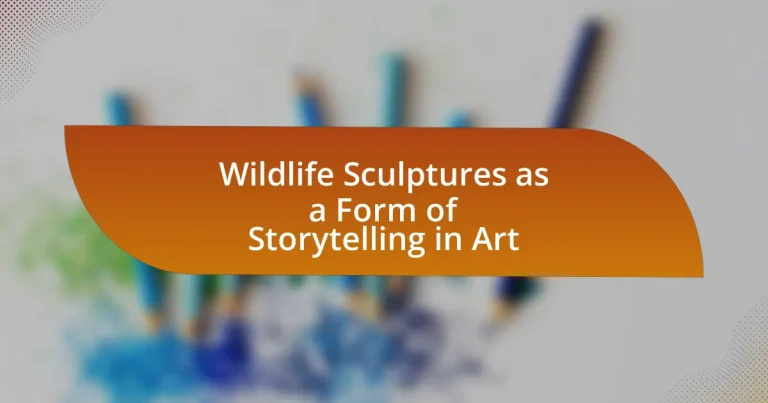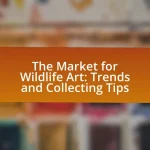Wildlife sculptures are three-dimensional representations of animals crafted from various materials, serving as a medium for artists to express their connection to nature and convey narratives about wildlife. These sculptures play a significant role in art by highlighting themes of conservation and the human-animal relationship, utilizing techniques such as dynamic poses and intricate detailing to enhance storytelling. The choice of materials influences the emotional resonance of the artwork, while cultural themes embedded in these sculptures reflect the interconnectedness of life and the environment. Additionally, wildlife sculptures are created through a meticulous process that involves research, sculpting, and refining, ultimately transforming them into powerful tools for raising awareness about ecological issues and fostering dialogue about the natural world.

What are Wildlife Sculptures and Their Role in Art?
Wildlife sculptures are three-dimensional representations of animals, created using various materials such as stone, metal, or wood. These sculptures serve as a medium for artists to express their connection to nature and convey narratives about wildlife, often highlighting themes of conservation and the relationship between humans and animals. For instance, renowned wildlife sculptor Robert Bateman emphasizes the importance of depicting animals in their natural habitats to raise awareness about environmental issues. Thus, wildlife sculptures play a significant role in art by not only showcasing artistic skill but also fostering dialogue about ecological preservation and the intrinsic value of wildlife.
How do Wildlife Sculptures convey stories?
Wildlife sculptures convey stories by capturing the essence of animals and their interactions within their environments, often reflecting themes of nature, survival, and the human-animal relationship. These sculptures utilize form, texture, and detail to evoke emotions and provoke thought, allowing viewers to interpret narratives about the depicted species. For instance, a sculpture of a mother bear with her cubs can symbolize nurturing and protection, while a lone wolf might represent solitude or resilience. The craftsmanship and artistic choices made by the sculptor further enhance the storytelling aspect, as specific poses and expressions can communicate a range of emotions and scenarios, effectively engaging the audience in a visual narrative.
What techniques are used in Wildlife Sculptures to enhance storytelling?
Wildlife sculptures enhance storytelling through techniques such as dynamic poses, intricate detailing, and contextual settings. Dynamic poses capture the movement and behavior of animals, allowing viewers to infer narratives about their interactions and environments. Intricate detailing, including textures and expressions, adds emotional depth, making the subjects relatable and engaging. Contextual settings, such as incorporating elements of the animal’s habitat, provide a backdrop that enriches the story being told, grounding the sculpture in a specific ecological narrative. These techniques collectively create a compelling visual language that communicates complex stories about wildlife and their ecosystems.
How do materials influence the narrative of Wildlife Sculptures?
Materials significantly influence the narrative of wildlife sculptures by determining the texture, form, and emotional resonance of the artwork. For instance, bronze conveys a sense of permanence and strength, often used to depict majestic animals, thereby enhancing themes of endurance and legacy. In contrast, wood can evoke warmth and organic connection, suitable for representing creatures in their natural habitats, which emphasizes themes of life and growth. Additionally, the choice of materials can reflect cultural significance; for example, indigenous artists may use local stones or clay to connect their sculptures to ancestral stories and traditions. This interplay between material and narrative shapes the viewer’s understanding and emotional response to the artwork, reinforcing the storytelling aspect inherent in wildlife sculptures.
Why are Wildlife Sculptures significant in cultural storytelling?
Wildlife sculptures are significant in cultural storytelling because they embody the relationship between humans and nature, conveying narratives that reflect cultural values, beliefs, and traditions. These sculptures often represent animals that hold symbolic meanings within specific cultures, serving as visual metaphors for human experiences, moral lessons, or historical events. For instance, in many Indigenous cultures, animals depicted in sculptures are integral to creation stories and spiritual beliefs, illustrating the interconnectedness of life and the environment. This significance is further supported by the fact that wildlife sculptures have been used for centuries across various cultures, from ancient civilizations to contemporary art, highlighting their enduring role in preserving and communicating cultural heritage.
What cultural themes are commonly represented in Wildlife Sculptures?
Cultural themes commonly represented in wildlife sculptures include the interconnectedness of nature, the symbolism of animals in mythology, and the reflection of environmental conservation. These themes illustrate how wildlife is perceived within various cultures, often highlighting the spiritual significance of animals and their roles in ecosystems. For instance, many Indigenous cultures depict animals as totems or spiritual guides, emphasizing their importance in storytelling and cultural identity. Additionally, contemporary wildlife sculptures frequently address issues of habitat loss and climate change, showcasing a commitment to environmental awareness and advocacy.
How do Wildlife Sculptures reflect the relationship between humans and nature?
Wildlife sculptures reflect the relationship between humans and nature by embodying the interconnectedness and mutual influence of both. These sculptures often depict animals in their natural habitats, illustrating the beauty and complexity of ecosystems, which highlights humanity’s role as both a steward and a disruptor of nature. For instance, the works of artists like Andy Goldsworthy emphasize the transient beauty of wildlife, prompting viewers to consider their impact on the environment. Additionally, wildlife sculptures can serve as a medium for conservation messages, raising awareness about endangered species and the importance of biodiversity, thereby reinforcing the idea that human actions directly affect the natural world.
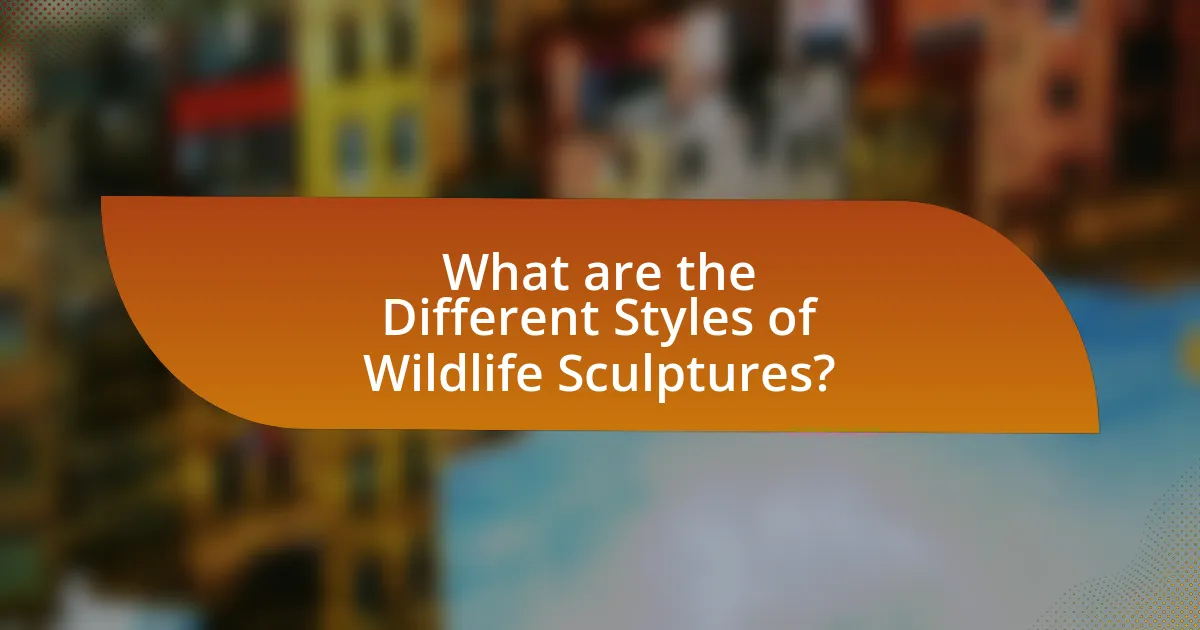
What are the Different Styles of Wildlife Sculptures?
Wildlife sculptures can be categorized into several distinct styles, including realistic, abstract, stylized, and kinetic. Realistic wildlife sculptures aim to accurately depict animals in their natural forms, often focusing on intricate details and lifelike representations. Abstract wildlife sculptures, on the other hand, emphasize shapes and forms rather than realistic portrayals, allowing for creative interpretations of animal figures. Stylized wildlife sculptures simplify and exaggerate features for artistic effect, often conveying a specific emotion or theme. Kinetic wildlife sculptures incorporate movement, engaging viewers in a dynamic experience. Each style serves as a unique method of storytelling, reflecting the artist’s vision and the relationship between humans and nature.
How do various artistic styles impact the storytelling aspect of Wildlife Sculptures?
Various artistic styles significantly influence the storytelling aspect of wildlife sculptures by shaping the emotional and narrative depth conveyed through the artwork. For instance, realism in wildlife sculptures captures intricate details of animals, allowing viewers to connect with the subject’s natural behavior and habitat, thereby enhancing the narrative of survival and coexistence. In contrast, abstract styles may evoke emotions or concepts related to wildlife, such as freedom or vulnerability, through simplified forms and colors, prompting viewers to interpret the story in a more personal and subjective manner. Additionally, cultural styles, such as Indigenous or African art, often embed specific narratives and spiritual beliefs about animals, enriching the storytelling by linking the sculptures to cultural heritage and environmental themes. This interplay between artistic style and storytelling is evident in the works of artists like Henry Moore, whose abstract forms suggest movement and life, and sculptors like Robert Bateman, who emphasize realism to tell stories of conservation and ecological awareness.
What are the characteristics of realistic Wildlife Sculptures?
Realistic wildlife sculptures are characterized by their attention to anatomical accuracy, lifelike textures, and dynamic poses that reflect the natural behavior of animals. These sculptures often utilize materials such as bronze, stone, or wood, which allow for intricate detailing that enhances realism. For instance, the fur or feathers are meticulously crafted to mimic the actual appearance of the animal, while the proportions and postures are designed to convey movement and vitality. Additionally, realistic wildlife sculptures often capture the essence of the animal’s habitat, providing context that enriches the storytelling aspect of the artwork. This combination of detail, material, and context serves to engage viewers and evoke an emotional response, making the sculptures not just representations of wildlife, but narratives that reflect the relationship between humans and nature.
How do abstract Wildlife Sculptures tell a different story?
Abstract wildlife sculptures convey a different story by emphasizing emotional and conceptual interpretations rather than realistic representations. These sculptures often utilize form, color, and texture to evoke feelings and ideas about nature and wildlife, allowing viewers to engage with the artwork on a personal level. For instance, an abstract representation of a bird might focus on fluid lines and vibrant colors to symbolize freedom and movement, rather than depicting the bird’s physical characteristics. This approach encourages diverse interpretations, as each viewer may project their own experiences and emotions onto the artwork, thus creating a unique narrative that transcends traditional storytelling methods found in realistic wildlife art.
What role does symbolism play in Wildlife Sculptures?
Symbolism plays a crucial role in wildlife sculptures by conveying deeper meanings and narratives associated with the depicted animals. Through the use of specific forms, materials, and artistic styles, sculptors can evoke emotions, represent cultural beliefs, and highlight ecological themes. For instance, a sculpture of an eagle may symbolize freedom and strength, while a turtle could represent longevity and wisdom. This symbolic representation allows viewers to engage with the artwork on a more profound level, prompting reflection on the relationship between humans and nature. The effectiveness of symbolism in wildlife sculptures is supported by art historical analysis, which shows that artists often use animal forms to communicate complex ideas and societal values, thus enriching the storytelling aspect of their work.
Which animals are most commonly used as symbols in Wildlife Sculptures?
The animals most commonly used as symbols in wildlife sculptures include eagles, wolves, bears, and deer. These animals are frequently chosen for their cultural significance and representation of various traits; for example, eagles symbolize freedom and strength, while wolves often represent loyalty and teamwork. Bears are associated with courage and power, and deer symbolize grace and gentleness. The prevalence of these animals in wildlife sculptures can be attributed to their deep-rooted connections in folklore and mythology, which enhance the storytelling aspect of the art form.
How does the choice of animal affect the story being told?
The choice of animal significantly influences the narrative conveyed in wildlife sculptures. Different animals symbolize various traits, emotions, and cultural meanings, which shape the viewer’s interpretation of the artwork. For instance, a lion often represents strength and courage, while a dove symbolizes peace and tranquility. This symbolic association guides the audience’s understanding of the story being told, as the characteristics attributed to the chosen animal can evoke specific feelings and thoughts. Additionally, the context in which the animal is depicted—such as its environment or interaction with other elements—further enhances the narrative, allowing artists to communicate complex themes and messages effectively.
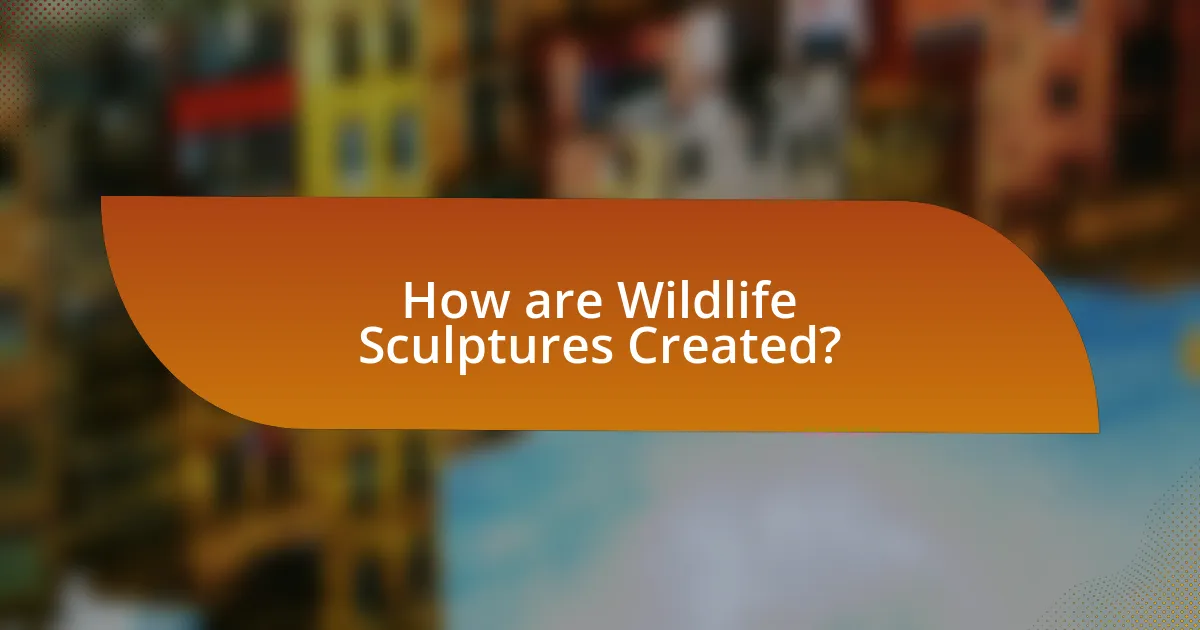
How are Wildlife Sculptures Created?
Wildlife sculptures are created through a process that typically involves selecting a subject, gathering reference materials, and then sculpting the piece using various materials such as clay, stone, or metal. Artists often begin by studying the anatomy and behavior of the chosen animal to ensure accuracy and realism in their work. Techniques such as modeling, carving, or casting are employed to shape the material into the desired form. For instance, a sculptor might use clay to create a detailed model before casting it in bronze, a method that has been used since ancient times, as evidenced by the numerous bronze animal sculptures found in archaeological sites. This meticulous approach not only captures the physical characteristics of wildlife but also conveys stories and emotions associated with the natural world.
What are the steps involved in creating a Wildlife Sculpture?
The steps involved in creating a wildlife sculpture include conceptualization, sketching, selecting materials, sculpting, refining details, and finishing. Initially, the artist conceptualizes the sculpture by researching the wildlife subject to understand its anatomy and behavior. Next, the artist sketches the design to visualize the final piece. Afterward, the artist selects appropriate materials, such as clay, stone, or metal, based on the desired outcome. The sculpting process follows, where the artist shapes the material into the desired form. Once the basic shape is established, the artist refines details to enhance realism and expression. Finally, the sculpture is finished with techniques like polishing, painting, or applying protective coatings to ensure durability and aesthetic appeal. Each step is crucial for achieving a lifelike representation that tells a story about the wildlife depicted.
How does the artist’s vision shape the final piece?
The artist’s vision fundamentally shapes the final piece by guiding the conceptualization, design, and execution of the sculpture. This vision influences the choice of materials, the representation of wildlife, and the narrative conveyed through the artwork. For instance, an artist focused on conservation may depict endangered species in a way that highlights their plight, thereby fostering awareness and empathy in the viewer. This intentionality in representation is crucial, as it transforms a mere sculpture into a storytelling medium that communicates deeper messages about nature and humanity’s relationship with it.
What tools and techniques are essential for sculpting wildlife?
Essential tools for sculpting wildlife include clay, wire armatures, sculpting tools, and carving tools. Clay serves as the primary medium, allowing for detailed modeling of animal forms. Wire armatures provide structural support, ensuring stability during the sculpting process. Sculpting tools, such as loop tools and spatulas, facilitate the shaping and detailing of the clay, while carving tools enable the artist to refine textures and features, enhancing realism. Techniques such as observation of live animals or reference photographs are crucial for capturing accurate proportions and anatomical details, which are vital for creating lifelike representations.
What challenges do artists face when creating Wildlife Sculptures?
Artists face several challenges when creating wildlife sculptures, including the need for accurate anatomical representation, the difficulty of capturing movement and emotion, and the limitations of materials. Accurate anatomical representation is crucial for authenticity; artists must study the anatomy of the animals they depict to ensure realism. Capturing movement and emotion poses a challenge as artists strive to convey the dynamic nature of wildlife, which requires a deep understanding of animal behavior. Additionally, the choice of materials can limit the artist’s ability to achieve desired textures and details, as different materials have unique properties that affect the final outcome. These challenges necessitate a combination of artistic skill, research, and material knowledge to create compelling wildlife sculptures that effectively tell a story.
How do environmental concerns influence the creation of Wildlife Sculptures?
Environmental concerns significantly influence the creation of wildlife sculptures by prompting artists to reflect ecological issues and advocate for conservation. Artists often use their work to raise awareness about habitat destruction, climate change, and endangered species, thereby transforming sculptures into powerful messages about the environment. For instance, the use of recycled materials in wildlife sculptures not only emphasizes sustainability but also highlights the impact of pollution on wildlife. This approach aligns with the growing trend among artists to engage with environmental themes, as seen in the works of artists like Chris Jordan, who focuses on the consequences of consumerism on nature. Such artistic expressions serve to educate the public and inspire action towards environmental preservation.
What are common misconceptions about Wildlife Sculpture artistry?
Common misconceptions about wildlife sculpture artistry include the belief that it is merely decorative or lacks depth in storytelling. In reality, wildlife sculptures often convey complex narratives about nature, conservation, and the relationship between humans and animals. For instance, many artists use their work to raise awareness about endangered species, illustrating the urgency of conservation efforts through their art. Additionally, some people assume that wildlife sculptures are only created from traditional materials like stone or wood; however, contemporary artists frequently incorporate mixed media, including metal and recycled materials, to enhance their storytelling. This demonstrates that wildlife sculpture is not only an aesthetic pursuit but also a powerful medium for conveying important messages about the natural world.
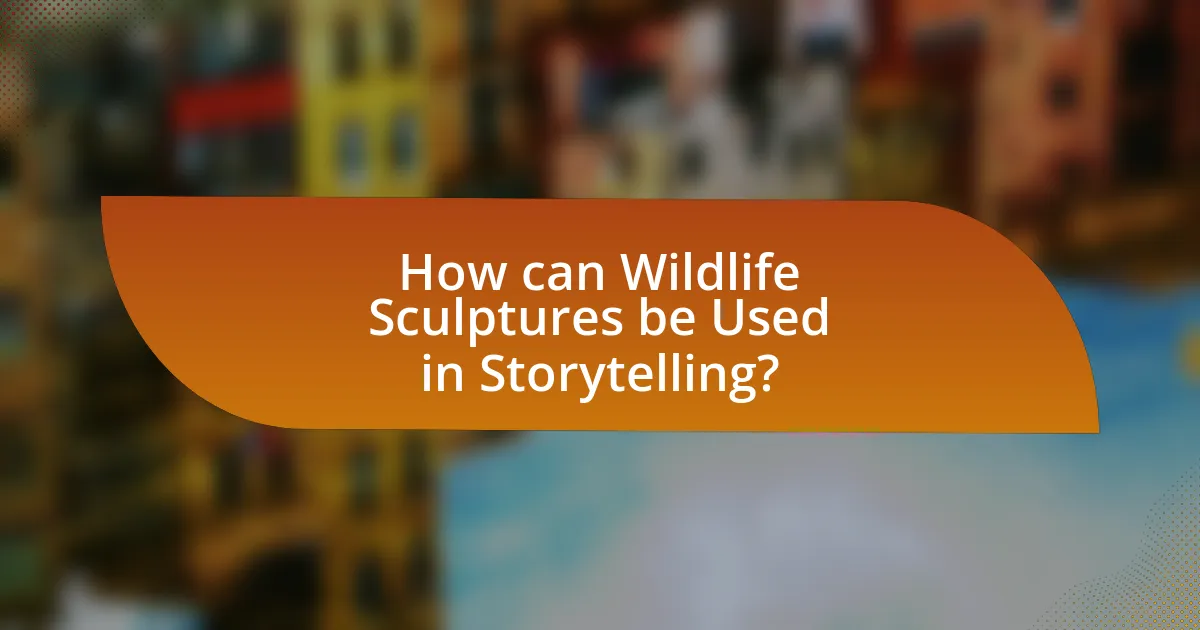
How can Wildlife Sculptures be Used in Storytelling?
Wildlife sculptures can be used in storytelling by visually representing narratives that highlight the relationship between animals and their environments. These sculptures can evoke emotions and convey messages about conservation, habitat loss, and the interconnectedness of life. For instance, a sculpture depicting a mother bear and her cubs can symbolize nurturing and protection, while also raising awareness about the threats faced by wildlife due to human activities. This method of storytelling engages viewers, prompting them to reflect on the stories behind the animals and their habitats, thereby fostering a deeper understanding of ecological issues.
What are effective ways to incorporate Wildlife Sculptures into narratives?
Effective ways to incorporate wildlife sculptures into narratives include using them as focal points that symbolize themes such as conservation, habitat loss, or the beauty of nature. By placing these sculptures in storytelling contexts, artists can evoke emotional responses and provoke thought about wildlife issues. For instance, a sculpture of an endangered species can serve as a powerful reminder of the need for preservation efforts, thereby enhancing the narrative’s impact. Additionally, integrating wildlife sculptures into public spaces or exhibitions can create immersive experiences that engage audiences and encourage dialogue about environmental stewardship. This approach aligns with the growing trend of using art to raise awareness about ecological concerns, as seen in various art installations worldwide that highlight the relationship between humans and wildlife.
How can Wildlife Sculptures enhance educational storytelling?
Wildlife sculptures enhance educational storytelling by providing a tangible representation of animals and their habitats, which facilitates deeper understanding and engagement. These sculptures serve as visual aids that can illustrate complex ecological concepts, making them more accessible to learners. For instance, a sculpture depicting a specific species can evoke discussions about biodiversity, conservation, and the interdependence of ecosystems. Research indicates that visual learning can improve retention of information; therefore, incorporating wildlife sculptures into educational settings can significantly enhance the storytelling experience by making abstract ideas more concrete and relatable.
What role do Wildlife Sculptures play in public art installations?
Wildlife sculptures serve as a vital component in public art installations by enhancing community engagement and fostering environmental awareness. These sculptures often depict animals in their natural habitats, which can evoke emotional responses and provoke discussions about conservation and biodiversity. For instance, a study by the National Endowment for the Arts highlights that public art, including wildlife sculptures, can significantly increase community pride and participation in local environmental initiatives. By integrating artistic expression with themes of nature, wildlife sculptures not only beautify public spaces but also educate the public about ecological issues, making them an effective storytelling medium in art.
What are some best practices for appreciating Wildlife Sculptures as storytelling art?
To appreciate wildlife sculptures as storytelling art, viewers should engage with the piece by observing the details, understanding the context, and reflecting on the narrative it conveys. Observing the intricate details, such as texture and form, allows one to appreciate the craftsmanship and the emotions the artist intended to evoke. Understanding the context involves researching the artist’s background, the cultural significance of the depicted wildlife, and the environmental themes often represented in such sculptures. Reflecting on the narrative encourages viewers to consider the stories behind the animals, their habitats, and the broader ecological messages, which can enhance the emotional connection to the artwork. These practices are supported by art appreciation studies that emphasize the importance of context and emotional engagement in understanding art.
How can viewers engage more deeply with the stories behind Wildlife Sculptures?
Viewers can engage more deeply with the stories behind Wildlife Sculptures by participating in guided tours that provide context and background information about the sculptures and their subjects. These tours often include insights into the artist’s intentions, the ecological significance of the depicted wildlife, and the cultural narratives associated with the species. Research indicates that interactive experiences, such as workshops or artist talks, enhance viewer understanding and appreciation, as they allow for direct interaction with the creators and the stories they aim to convey. Engaging with multimedia resources, such as documentaries or augmented reality applications that accompany exhibitions, can also deepen the viewer’s connection to the narratives embedded in the sculptures.
What questions should one ask when interpreting a Wildlife Sculpture?
When interpreting a Wildlife Sculpture, one should ask the following questions: What animal or species is represented, and what does it symbolize in the context of the artwork? Understanding the specific animal can provide insight into the themes of nature, conservation, or cultural significance. Additionally, one should consider the materials and techniques used in the sculpture; for example, whether it is carved from wood, stone, or metal can influence its aesthetic and emotional impact. Furthermore, asking about the artist’s intent and background can reveal the narrative or message behind the piece, as many wildlife sculptures aim to evoke a connection to the natural world or raise awareness about environmental issues. Lastly, examining the sculpture’s placement and interaction with its surroundings can enhance the interpretation, as context often plays a crucial role in storytelling through art.
